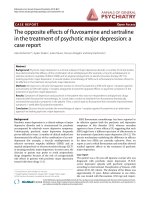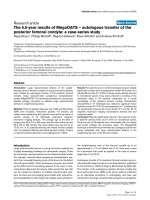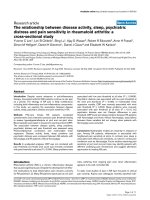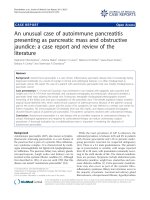Báo cáo y học: " The Psychiatric Case Register Middle Netherlands" pot
Bạn đang xem bản rút gọn của tài liệu. Xem và tải ngay bản đầy đủ của tài liệu tại đây (242.85 KB, 6 trang )
CORRE S P O NDEN C E Open Access
The Psychiatric Case Register Middle Netherlands
Hugo M Smeets
1*
, Wijnand Laan
1
, Iris M Engelhard
2,3
, Marco PM Boks
1
, Mirjam I Geerlings
1
and Niek J de Wit
1
Abstract
Background: The Psychiatric Case Register Middle Netherlands (PCR-MN) registers the mental healthcare
consumption of over Dutch 760,000 inhabitants in the centre of the Netherlands. In 2010 the follow-up period was
over ten years. In this paper we describe the content, aims and research potential of this case register.
Description: All mental healthcare institutions in the middle-western part of the province of Utrecht participate in
the PCR-MN case register. All in- and out-patients treated in these institutions have been included in the database
from the period 2000 to 2010. Diagnosis according to DSM-IV on axis I to IV, visits to in- and out-patient clinics
and basic demographics are recorded. A major advantage of this register is the poss ibility to link patients
anonymously from the PCR-MN cohort to other databases to analyze relationships with determinants and
outcomes, such as somatic healthcare consum ption, mortality, and demographics, which further increases the
research potential
Conclusions: The PCR-MN database has a large potential for scientific research because of its size, duration of
follow-up and ability to link with additional databases, and is accessible for academic researchers.
Background
Psychiatric case registers (PCRs) are described as
‘patient-centered longitudinal records of contacts with a
defined set of psychiatric services originating from a
defined population’[1]. In Denm ark sys tematic coll ection
of psychiatric data existed as early as 1938 and computer-
ized recording of data started in 1969 [2]. T he first regis-
ters in Great Britain arose around the 1960s. The
Netherlands originally had three PCRs, one in the north,
one in the south, and one in the west, of which the oldest
goes back to the 1970s [3]. Around the end of the 1990s
a fourth PCR was founded; the Psychiatric Case Register
Middle Netherlands (PCR-MN). From the beginning this
PCR has focused on the potential linkage of its registered
mental health data to additional sources of data. This
paper aims to describe the PCR-MN case register and its
potentials for research to inform researchers and invite
them to cooperate in scientific research.
Purpose of the Psychiatric Case Register
Traditionally, mental healthcare in the Netherlands was
funded by a special social legislation programme,
separate from the general medical care funding. Given
the open-end, lump sum based funding, mental health
institutions used to record psychiatric patient manage-
ment inadequately. Because of the need for a better
understanding of the psychiatric patient population, the
need for analysis of treatment efficacy and increasing
costs, regional databases on patients treated in mental
health care were founded. The Dutch government pro-
vided financial support for the development of such
databases, because they provided detailed information
about the morbidity, characteristics a nd costs of mental
health provision. In the last decade the demand for
good healthcare information has been reinforced by
changes of the funding s ystem into individual reim-
bursed expenses. Therefore the mental healthcare insti-
tutions in the central province of Utrecht created the
fourth case register, with data from 1999 onwards, offer-
ing opportunit ies for epidemiologic research in psychi a-
try. To strengthen the infrastructure and facilitate
research within the database the case regis ter was incor-
porated in the Julius Center for Health Sciences and Pri-
mary Care of the University Medical Center Utrecht in
2008 and now receives a structural funding from the
Dutch Ministry of Health.
* Correspondence:
1
Julius Center for Health Sciences and Primary Care, University Medical
Center Utrecht, Utrecht, The Netherlands
Full list of author information is available at the end of the article
Smeets et al. BMC Psychiatry 2011, 11:106
/>© 2011 Smeets et al; licensee BioMed Central Ltd. This is an Op en Access a rticle distributed u nder the terms of the Cre ative Commons
Attribution License ( /by/2.0), which pe rmits unrestricted use, dis tribu tion, and reproduction in
any medium, provided the original work is properly cited.
Construction and Content
The study area
The PCR-MN database covers the mid-western part of
the province of Utrecht, the Netherlands and included
over 760,000 inhabitants in 2010. This is a representa-
tive sample of 5% of the total Dutch population in
urban, semi-rural and rural areas, including the main
city of Utrecht. Approximately 10% of the population is
of non-Dutch origin. From 2011 the database will be
extended with mental health institutions in the north-
eastern part and will cover then the whole province of
Utrecht with over 1.2 million inhabitants
The participating centers
All mental health care institutions in the region partici-
pate in the PCR-MN. All patients who consult these
institutions and are treated are included in the database,
both in and outpatients. The psychiatric hospitals,
Altrecht Mental Health Care, St. Antonius Hospital and
University Medical Center, focus on all psychiatric dis-
orders, both for patients with and without a referral
from the general practitioner and provide both inpatient
and outpatient care. Sixty private psychotherapists are
also affiliated with PCR. Center Maliebaan is the main
provider of addiction services and two non-profit foun-
dations, Kwintes and SBWU, provide the assisted living
in the PCR-MN region. The GG&GD Utrecht (munici-
pal health authority) monitors the mental and social
healthcare of homeless, socially isolated or other malad-
justed people in the in the city of Utrecht. Over the last
years about 60,000 patients were registered annually in
the database of which 75% was treated in Alt recht
MHC. Furthermore the database contains about 5000
addicted patients and 6000 persons in assisted living
situations.
Representatives of the participating institutions serve
on the advisory board of the PCR-MN in which they
advise on the policy of the register and the use of data
for research.
Data recorded in the PCR-MN
At the beginning of each calendar year, all informati on
on demographic characteristics, diagnosis and type o f
care provided is collected from the participating centers.
Basic demographics include date of birth, gender, the
first part of the postal-code, country of birth of the
patients and country of bi rth of his or her parents. Both
the diagnosis at intake and at discharge are recorded
using the DSM-IV axis I to IV[4]. Table 1 presents the
number of patients per year within the main DSM-IV
axis I and II chapters, for citizens of the area covered by
the PCR-MN. As can be seen here, the most frequently
diagnosed disorders are mood disorders and overall, the
number of patients per diagnostic chapter is increasing
over the years. The type of care is recorded per day on
an individual level, and it is possible to follow individual
patients over the participating hospitals (Table 2).
Ethics and privacy
Dutch privacy law allows the use of personal (health-
care) data on behalf of scientific research if a number of
demands are met. The most important one is that
Table 1 Total cases with the most common DSM-IV axis one and two diagnoses
Chapter 2002 2003 2004 2005 2006 2007 2008 2009
Number Name PCR PCR PCR PCR PCR PCR PCR PCR
1 Disorders usually first diagnosed in childhood 1,010 1,305 1,661 2,074 2,555 2,730 4,490 4,262
2 Delirium, dementia, and amnestic and other cognitive dis. 519 644 913 1,243 1,663 1,675 1,891 1,925
3 Mental disorders due to a general medical condition NEC 43 68 70 82 155 114 177 209
4 Substance-related disorders 1,453 1,093 1,612 3,179 3,438 2,804 5,691 4,764
5 Schizophrenia and other psychotic disorders 969 1,097 1,270 1,624 2,588 1,677 1,900 1,758
6 Mood disorders 3,519 4,198 4,913 5,504 6,581 6,271 7,189 6,586
7 Anxiety disorders 1,676 2,135 2,620 3,043 3,520 3,593 4,269 4,359
8 Somatoform disorders 538 651 818 974 974 1,163 1,296 1,307
9 Factitious disorders 6 8 10 12 16 11 20 20
10 Dissociative disorders 64 65 103 108 141 145 147 144
11 Sexual and gender identity disorders 530 711 907 1,036 953 1,445 1,943 1,952
12 Eating disorders 365 403 562 772 845 842 988 1,061
13 Sleep disorders 29 28 47 63 44 96 122 159
14 Impulse-control disorders NEC 174 190 246 348 355 444 640 640
15 Adjustment disorders 904 1,250 1,567 1,756 1,896 2,711 3,639 4,070
16 Personality disorders (Axis II) 1,543 1,820 2,293 2,815 3,648 3,311 4,980 5,051
A diagnosis was counted when it was made during the specified calendar year or the year prior to the specified calendar year.
Smeets et al. BMC Psychiatry 2011, 11:106
/>Page 2 of 6
individual patient d ata can not be traced to an indivi-
dual. In the PCR-MN database, identifying variables a re
encrypted, which makes it impossible for researchers to
identify individual patients. A research review commis-
sion decides whether a request of an investigative body
for the delivery of data for research can be met. Datasets
are made available strictly under the condition of anon-
ymity, safe data storage and inacce ssibility to others.
After use, the destruction of all data sets is mandatory.
Additional data for research
The large size of PCR-MN data only on diagnoses and
treatment are insufficient for most observational
research projects. Studies such as intervention and prog-
nostic studies can be performed in cohort and case-con-
trol designs, but need more determinants and
confounding variables in their analyses. Potential linkage
to other sources of data can be used to enrich the data-
base, which can supplement the available clinical infor-
mation and p atient characteristics. The most important
databases for this data linkage are the databases of Agis
Health Insurance Company (Agis), which is the lar gest
healthcare insurer in the province of Utrecht, Statistics
Netherlands with information of all residences and the
Network of General Practitioners within the Utrecht
region.
Linking with Agis Health Database
Agis Health Insurance Company (Agis) is the main
health insurance company in the central part of the
Netherlands. In the Agis Health Database (AHD) the
payments for the provision of all medical care to its
insured patients is recorded. This includes extensive
records of all outpatient diagnostic and therapeutic
interventions, such as all drugs delivered by pharmacists,
health services delivered by hospitals, general practi-
tioners and other primary care professionals. The AHD
is described extensively elsewhere [5].
Around two third of all PCR-MN patients are insured
by Agis (Figure 1). Agis has a la rge proportion of clients
from lower socioeconomic standard which may result in
an overrepresentation in a group successfully linked
patients. Once individual case linkage is established, all
reimbursed healthcare intervention can be retrieved
from the AGIS database. By linking the psychiatric
healthcare from the PCR-MN to somatic healthcare
consump tion, it is, for example, possible to evaluate the
influence of somatic co-morbidity on the effectiveness
of psychiatric interventions.
Linking with Statistics Netherlands
In the Netherlands, Statistics Net herlands (CBS) is
responsible for collecting and processing data in order
to publish statistics to be used in practice, by policy-
makers and for scientific research. T he published infor-
mation of Statistics Neth erlands incorporates a
multitude of societal aspects, such as the incomes of
individual people and their education [6]. Statistics
Netherlands makes its datasets available for scientific
research under the condition of stric t confidence, and
without any identifying variables. Linking of cases from
the PCR-MN case register to the database of CBS leads
to a match around 80% of all cases (Figure 1). A double
match often occurs when two or more persons live in
the same postal-code area. Analyzing data from Statis-
tics Netherlands used to be done by a remote access
terminal and data can never b e downloaded (see their
homepage, />Linking with General Practitioners Network
From 2011 several smaller General Practitioner Net-
works will join forces in the large Julius General Practi-
tioner Network (JHN) that has stationed its database in
the University Medical Center of Utrecht. The network
contains over 300.000 residences in th e Utrecht region,
which makes it attractive for matching case s of the
PCR-MN database. The JHN data contain the diagnostic
codes (ICPC) of all consulting patients, prescribed drugs
(ATC) as well as referral and laboratory information. In
the near feature matching procedures will be elaborated,
so linkage with the PCR-MN will become easy for study
purposes.
Utility and Discussion
Studies using the Psychiatric Case Register Middle
Netherlands
Routine databases like the PCR-MN are attractive for
research because of their large size, longitudinal per-
spective, and practice -based information. Several studies
have already been conducted using data from the PCR-
MN case register. From an epid emiological perspective,
etiological, intervention and prognostic studies are feasi-
ble with and without using links to other sources for
Table 2 Total patients receiving inpatient, outpatient, crisis or assisted living care per year for the main categories of
care
2002 2003 2004 2005 2006 2007 2008 2009
Inpatient care 3,693 3,696 4,245 4,547 4,691 5,304 5,673 5,629
Outpatient care 24,236 26,092 32,467 34,738 37,768 44,809 49,012 51,914
Crisis care 3,379 3,612 4,069 4,204 3,936 4,133 4,144 4,691
Assisted living 891 1,123 1,769 2,056 2,510 4,557 5,328 5,436
Smeets et al. BMC Psychiatry 2011, 11:106
/>Page 3 of 6
additional information. Below we will give a number of
examples using the linked PCR-MN database.
One study examined whether being diagnosed with
both an anxiety disorder and a depression increases
the hazard-ratio for death during follow-up compared
to only one of these disorders. All cases were linked to
the c auses of death register of Statistics Netherlands in
a 10 year follow-up cohort study, together with a ran-
dom control group, after the initial diagnosis. An
increased risk was demonstrated in patients with an
anxiety disorder and in patients with a depression.
However, the hazard ratio among people with both
disorders was similar to those with only a depression
(Laan W, Termorshuizen F, Smeets HM, Boks M, Wit
NJ, Geerlings MI. A comorbid anxiety disorder does
not result in an excess risk of death above the risk of
death associated with a depressive disorder alone. Sub-
mitted ). A second study was perfor med on the risk of
several psychiatric disorders among minorities in
Utrecht compared to Dutch natives. All cases with a
relevant psychiatric diagnosis were subsequently linked
to their birth records in the database of Statistics
Netherlands. The findings i n this cohort study showed
significantly increased relative risks for treatment
because of a depression or a non-affective psychosis
among all immigrant groups [7].
In another case-control stud y, we investigated whether
the use of corticosteroids was associated with a decreased
risk of subsequent psychosis. All glucocorticosteroid pre-
scriptions prior to t he first registered psychotic episode
in patients from the PCR-MN database were extracted
from the AHD. Then the number of defined daily doses
(DDDs [8]) was compared to a control group and the
results showed that the risk of psychosis was lower in
those who have used these drugs [9].
In a prognostic study at last the effect of non-compli-
ance to anti-psychotic drugs on the risk of a psychotic
relapse was measured. F rom all cases o f the PCR-MN
database that were discharged from an inpatient c linic
of Altrecht, the reimbursed antipsychotic drugs were
extracted from the AHD. The results of this study i ndi-
cated a significantly increased risk for relapse with
increasing non-compliance using a continuous compli-
ance scale [10].
Strengths and weaknesses
A major strength of the PCR-MN database is that it
enables researchers to do longitudinally studies without
Figure 1 Schematic overview of the overlap of the PCR-MN, Agis Health Database and Statistics Netherlands.
Smeets et al. BMC Psychiatry 2011, 11:106
/>Page 4 of 6
interfering with regular care, thus allowing cohort stu-
dies nested within the PCR-MN main cohort, but also
nested case-control studies. In a nested cohort, patients
are selected based upon a determinant in the cohort; in
a nested case-control study, patients are sampled based
on the outcome.
Another strength is that the PCR-MN covers all psy-
chiatric healthcare provided in the region. Patients
referred to another psychiatric ho spital in the region
can still be identified in the case-register.
Also, because the registration of diagnosis and psy-
chiatric contacts is based upon the financial databases of
the psychiatric centers, the registration is very accurate.
If the diagnoses are not registered well the costs will not
be reimbursed by the insurance company.
Finally, because the PCR-MN case register is one of
four Dutch psychiatric case-registers it is also possible
to compare results from the Utrecht region to other
regions covered by one of the o ther case-registers or
even to analyze aggregated data from the four PCRs
together.
A disadvantage of the registration in the PCR-MN is
that some patient characteristics are subject to changes
during follow-up. For example, the postal-code can
result in loss to follow-up, because a patient may move
to another part of the region and will not longer be
treated at the same psychiatric hospit al. The particular
patient would then be identified as a new patient
increasing the incidence and prevalence of disorders in
theregion.Also,patientswhodieormovefromthe
region are not reported as such to the PCR-MN. It is
difficult to determine to what extent this loss to follow-
up occurs
A second limitation is that diagnoses in the PCR-MN
are clinical diagnoses and not the result of a standar-
dized structured diagnostic questionnaire. Also the rea-
son to termina te psychi atric healthcare is not registered
i.e. it is unknown if the patient is cured.
Future developments
From 2010 onward we aim to also include the Axis 5
(Global Assessment of Functioning (GAF) score) of the
DSM-IV in the P CR-MN database. The GAF score is a
numeric scale with a range of 0 to 100 that aims to
describe the social, occupational, and psychological
functioning of a person.
In the coming years, the identification of patients in
the database based upon the gender, postal code and
date of birth will be replaced by a registration based
upon the Dutch social security number (BSN). This
requires the use of a ‘third trusted party’ to protect the
privacy of patients in the case-register, which is cur-
rently being explored.
Conclusions
The Psychiatric Case Register Middle Netherlands regis-
ters the psychiatric healthcare consumption and diagno-
sis of over 750,000 inhabitants. The PCR-MN now has a
follow-up period of ten years. To aid scientific research ,
cases from this database can be linked to other data-
bases covering roughly the same population. By linking
these databases, psychiatric healthcare consumption,
somatic healthcare consumption and important demo-
graphic variables can be studied. This resource is instru-
mental in psychiatric epidemiological studies and
facilitates cohort and case-control studies.
Availability and requirements
The PCR-MN database is available for academic
research only. Scientists are encouraged to submit
research proposals in which data from the PCR-MN can
be used. To guarantee the feasibility and o riginality of
the research performed and the privacy of those in the
database all research proposals will be evaluated by a
research review commission. The PCR-MN researches
can be contacted through the corresponding author.
List of abbreviations
AHD: Agis Health Database; ATC: Anatomical Therapeutic Chemical
Classification System; CBS: Statistics Netherlands; DDD: Defined Daily Doses;
DSM-IV: Diagnostic and Statistical Manual of Metal Disorders; GG&GD:
Municipal Public Health Department; ICPC: Inter national Classification of
Primary Care; JHN: Julius General Practitioner Network; PCR-MN: Psychiatric
Case Register Middle Netherlands; UMC: University Medical Centre
Author details
1
Julius Center for Health Sciences and Primary Care, University Medical
Center Utrecht, Utrecht, The Netherlands.
2
Clinical and Health Psychology,
Utrecht University, Utrecht, The Netherlands.
3
Altrecht, Institute for Mental
Health Care, Utrecht, The Nethe rlands.
Authors’ contributions
HMS and WL designed the content structure and provided the figures of
the description of the PCR-MN. IE and MB represent the psychiatry
institutions and contributed to the content of the data. MG and NdeW
represent study groups of the PCR-MN and contributed to the utility of the
database. All authors read and approved the final manuscript.
Competing interests
The authors declare that they have no competing interests.
Received: 24 August 2010 Accepted: 29 June 2011
Published: 29 June 2011
References
1. Perera G, Soremekun M, Breen G, Stewart R: The psychiatric case register:
noble past, challenging present, but exciting future. Br J Psychiatry 2009,
195:191-193.
2. Munk Jorgensen P, Mortensen PB: The Danish Psychiatric Central Register.
Dan Med Bull 1997, 44:82-4.
3. Wierdsma AI, Sytema S, van Os JJ, Mulder CL: Case registers in psychiatry:
do they still have a role for research and service monitoring? Curr Opin
Psychiatry 2008, 21:379-384.
4. American Psychiatric Association: Diagnostic and Statistical Manual of Mental
Disorders Dsm-IV-Tr (Text Revision) Washington DC: American Psychiatric
Press; 1994.
Smeets et al. BMC Psychiatry 2011, 11:106
/>Page 5 of 6
5. Smeets H, Wit NJ, Hoes AW: The use of routine health insurance data for
scientific research: potential and limitations of the AGIS HEALTH
DATABASE. J Clin Epid 2010, 64:424-30.
6. Centraal Bureau voor de Statistiek: Statline. 2009, Den Haag/Heerlen.
7. Selten JP, Laan W, Kupka R, Smeets HM, van Os J: Risk of psychiatric
treatment for mood disorders and psychotic disorders among migrants
and Dutch nationals in Utrecht, the Netherlands. Soc Psychiatry Psychiatr
Epidemiol 2011.
8. ATC/DDD Index 2010. [ />9. Laan W, Smeets H, de Wit NJ, Kahn RS, Grobbee DE, Burger H:
Glucocorticosteroids associated with a decreased risk of psychosis. J Clin
Psychopharmacol 2009, 29:288-290.
10. Laan W, van der Does Y, Sezgi B, Smeets H, Stolker JJ, Wit NJ, Heerdink ER:
Low treatment adherence with antipsychotics is associated with relapse
in psychotic disorders within six months after discharge.
Pharmacopsychiatry 2010, 43:221-4.
Pre-publication history
The pre-publication history for this paper can be accessed here:
/>doi:10.1186/1471-244X-11-106
Cite this article as: Smeets et al.: The Psychiatric Case Register Middle
Netherlands. BMC Psychiatry 2011 11:106.
Submit your next manuscript to BioMed Central
and take full advantage of:
• Convenient online submission
• Thorough peer review
• No space constraints or color figure charges
• Immediate publication on acceptance
• Inclusion in PubMed, CAS, Scopus and Google Scholar
• Research which is freely available for redistribution
Submit your manuscript at
www.biomedcentral.com/submit
Smeets et al. BMC Psychiatry 2011, 11:106
/>Page 6 of 6









